Concept and Inspiration¶
Family¶
 Growing up in a fmaily of 28 people really instilled in me the values of living in a community, that Co-existence, Co-operation and Interdependnce in the only way forward. Since I was a child I have seen the spirit of mutual existence,the spirit of helping each other at every step of the way and that has made 28 people living together under one roof possible. That is why when I read about this extraordinary relationship that the microorganisms and other beings around us have, it really inspired me.
Growing up in a fmaily of 28 people really instilled in me the values of living in a community, that Co-existence, Co-operation and Interdependnce in the only way forward. Since I was a child I have seen the spirit of mutual existence,the spirit of helping each other at every step of the way and that has made 28 people living together under one roof possible. That is why when I read about this extraordinary relationship that the microorganisms and other beings around us have, it really inspired me.
Mycorrhizae: The Symbiotic Relationship between Fungi and Roots¶
(Credits: LibreTexts A nutrient depletion zone can develop when there is rapid soil solution uptake, low nutrient concentration, low diffusion rate, or low soil moisture. These conditions are very common; therefore, most plants rely on fungi to facilitate the uptake of minerals from the soil. Mycorrhizae, known as root fungi, form symbiotic associations with plant roots. In these associations, the fungi are actually integrated into the physical structure of the root. The fungi colonize the living root tissue during active plant growth.
Through mycorrhization, the plant obtains phosphate and other minerals, such as zinc and copper, from the soil. The fungus obtains nutrients, such as sugars, from the plant root. Mycorrhizae help increase the surface area of the plant root system because hyphae, which are narrow, can spread beyond the nutrient depletion zone. Hyphae are long extensions of the fungus, which can grow into small soil pores that allow access to phosphorus otherwise unavailable to the plant. The beneficial effect on the plant is best observed in poor soils. The benefit to fungi is that they can obtain up to 20 percent of the total carbon accessed by plants. Mycorrhizae function as a physical barrier to pathogens. They also provides an induction of generalized host defense mechanisms, which sometimes involves the production of antibiotic compounds by the fungi. Fungi have also been found to have a protective role for plants rooted in soils with high metal concentrations, such as acidic and contaminated soils.
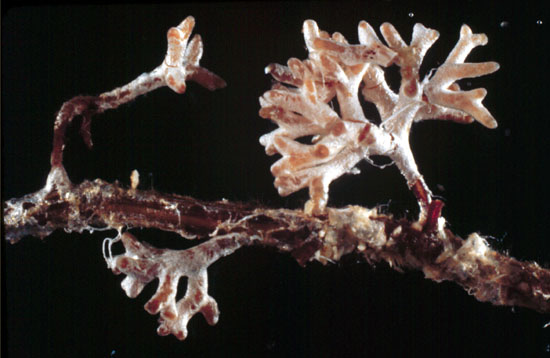
Hyphae proliferate within the mycorrhizae, which appears as off-white fuzz in this image. These hyphae greatly increase the surface area of the plant root, allowing it to reach areas that are not depleted of nutrients. There are two types of mycorrhizae: ectomycorrhizae and endomycorrhizae. Ectomycorrhizae form an extensive dense sheath around the roots, called a mantle. Hyphae from the fungi extend from the mantle into the soil, which increases the surface area for water and mineral absorption. This type of mycorrhizae is found in forest trees, especially conifers, birches, and oaks. Endomycorrhizae, also called arbuscular mycorrhizae, do not form a dense sheath over the root. Instead, the fungal mycelium is embedded within the root tissue. Endomycorrhizae are found in the roots of more than 80 percent of terrestrial plants. Ectomycorrhizae form sheaths, called a mantle, around the roots of plants, as shown in this image.
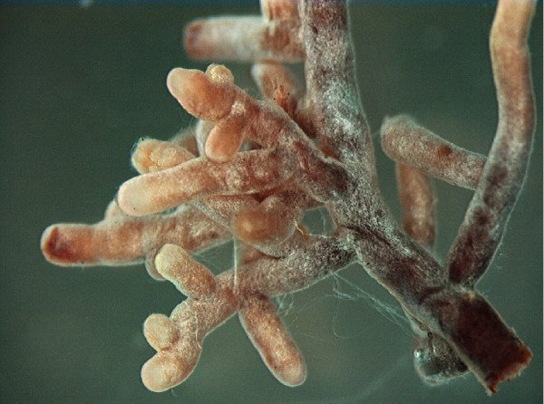
When mycorrhizae are present, plants are less susceptible to water stress. Not only do the fungal threads help to bring water and nutrition into the plant, but they also can store them for use when rainfall is sparse and temperatures are high. When organic matter (compost) is added to improve a soil, mycorrhizae are important in making its nutrients available. The residual organic matter and the hyphae improve the structure of the soil. Recent research indicates that the fungi even help break down rock, increasing availability of the essential nutrients within, such as potassium, calcium, zinc and magnesium.
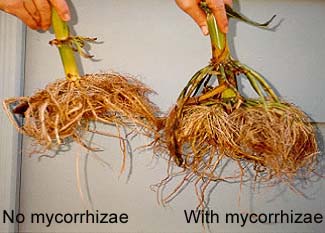
The Relationship between Plants and Bacteria¶
Similarly, according to https://asknature.org/strategy/mutualism-enhances-pollutant-breakdown/ Rhizobacteria and plants work together to help each other survive. This is called a mutualistic relationship. The plant gives the bacteria a place to live and provides them with nutrients through its roots. In return, bacteria take natural chemicals in the soil such as nitrogen and turn them into more useful kinds of chemicals such as ammonia, nitrates, and nitrites. Some chemicals the bacteria produce increase the size and surface area of roots so they have more contact with the soil. This increases nutrient and water uptake, making the plant stronger.
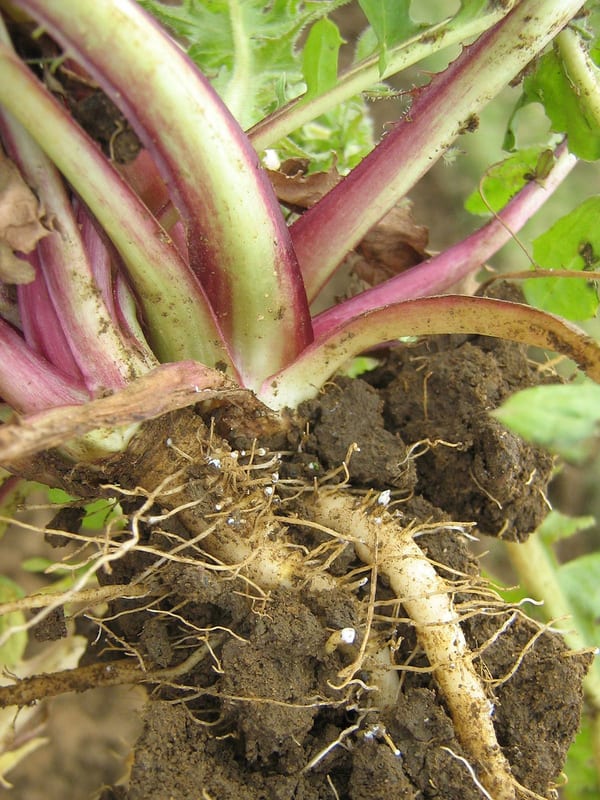
A group of bacteria called rhizobacteria live among plant roots in an area known as the rhizosphere.

Here is a simplified diagram showing the relationship between a plant and symbiotic bacteria in the root nodules.
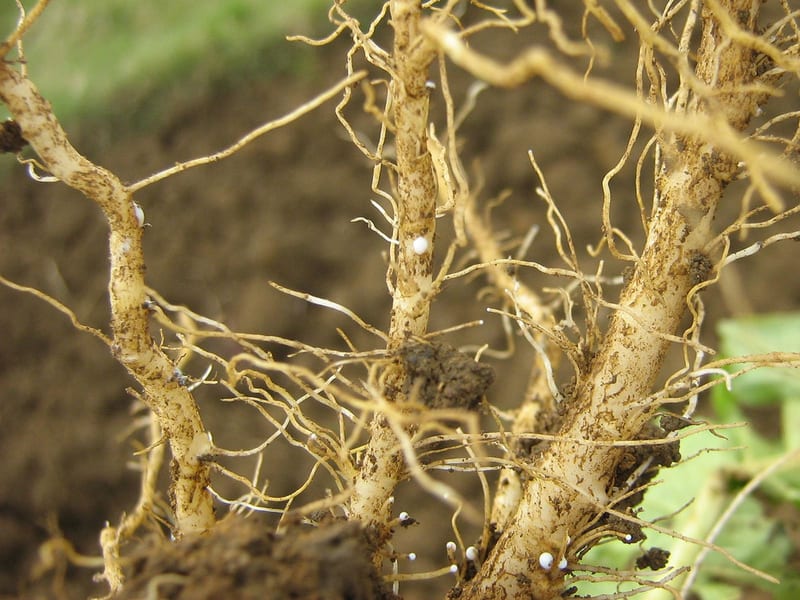
Rhizobacteria and plants work together in a mutualistic relationship to help each other survive.
What¶
A reflection of nature's collaborative subsistence to address major issues in the fashion industry
Bioremediation¶
What if we get inspried from this natural relationship which has existed before we even knew what these terms meant and make use of organisms around us to give back to nature and/or cause less harm to it and make a collection which celebrates this relationship.
Mycelium and microorganisms play a central and overlooked role in the lifecycle of the planet, breaking down matter and pollutants so that new life can emerge. These principles underpin not only the philosophy of the garments but also their forms. Through techniques that make use of these organisms and forms that are inspired from one of the end product, this collection aims to make use of various sustainable processes of production mainly textile dyeing to help move to a safer production cycle and a better future for fashion.
PLANTS + BACTERIA + FUNGI = NATURAL DYEING + BACTERIA DYEING + MYCELIUM
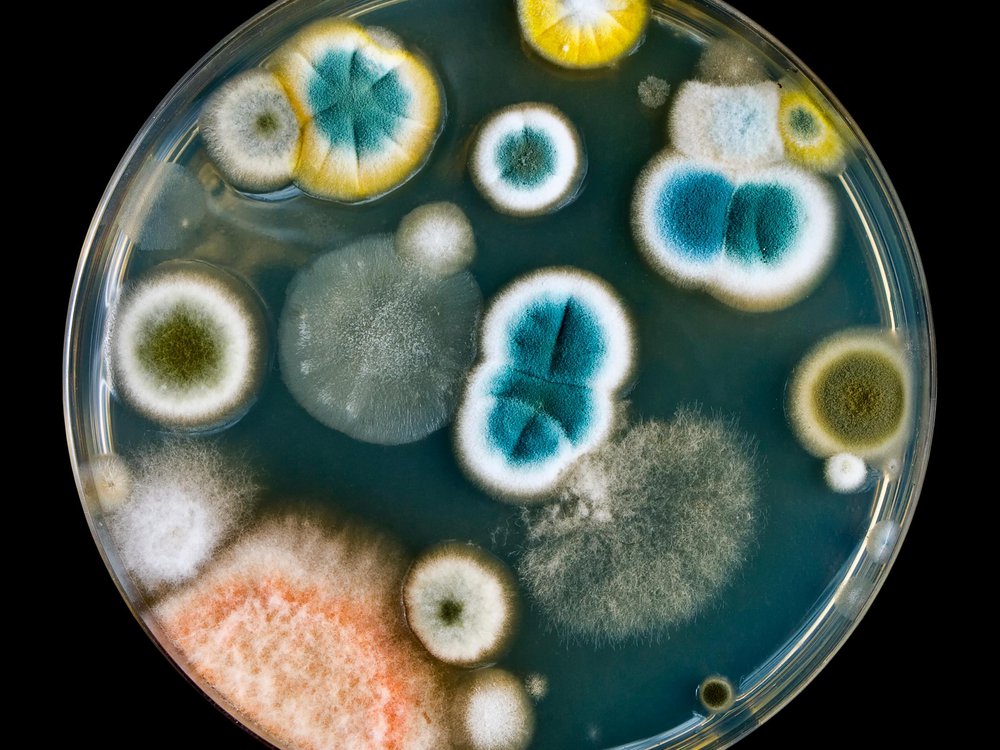
How¶
Plants - Natural Dyeing¶
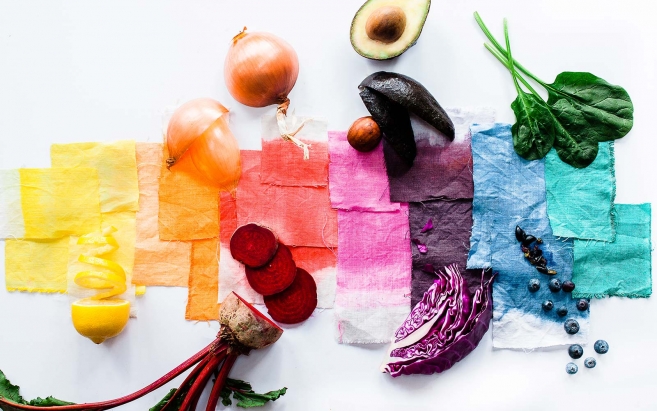
First is plants, in this case Onion Peels. Waste onion peels can be used to achieve beautiful shades of yellow and earthy pinks which not only makes use of waste material but also tackles a very m ajor issue of Synthetic Dyeing. This cuts down the harmful chemical being used to dye our clothes and makes the water being used safe to be discarded after use.
Bacteria - Bacteria Dyeing¶
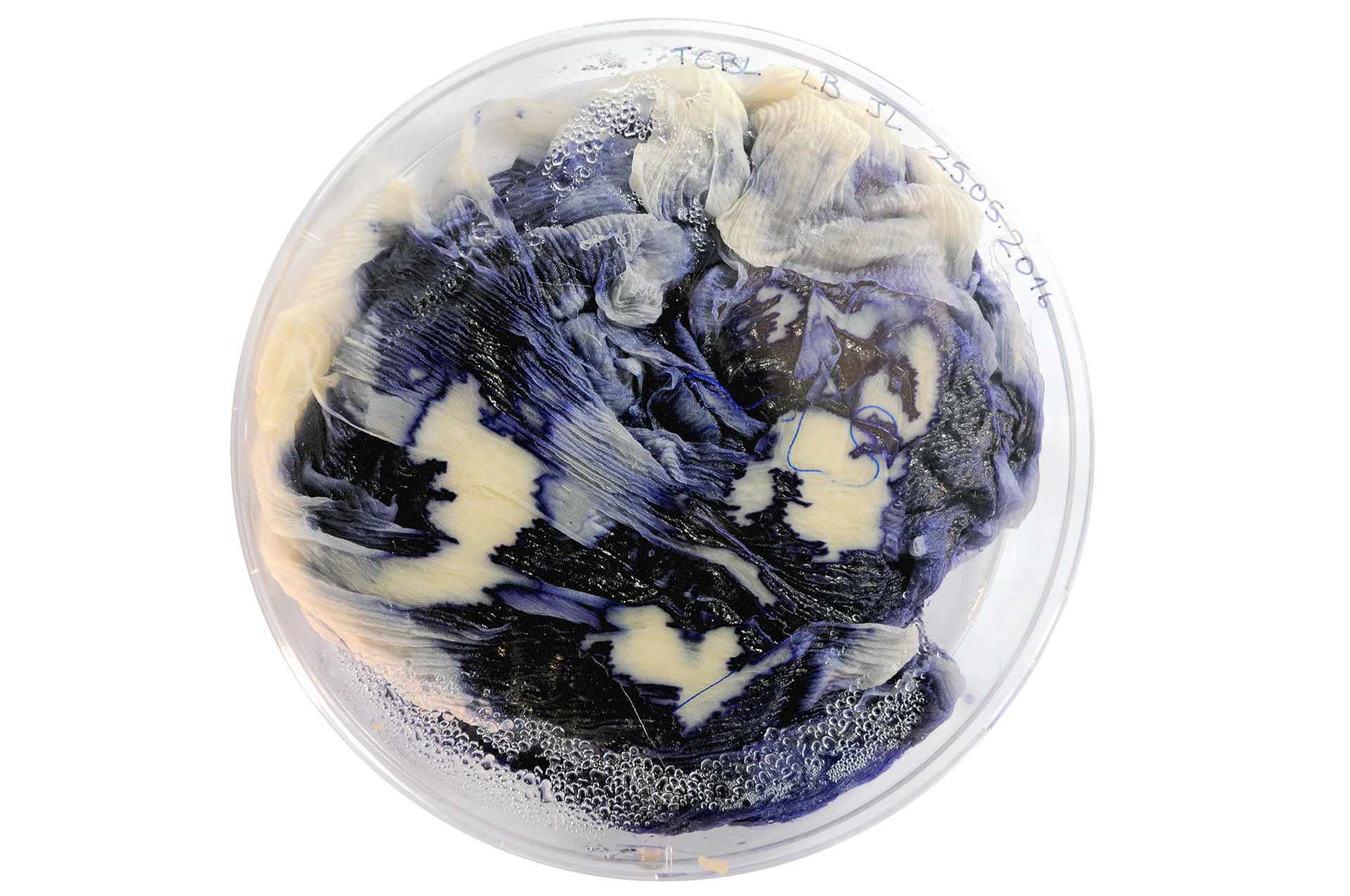
Second step is Bacteria Dyeing with Janthinobacterium Lividum. This step not only solves the problem of chemicals being used but also saves the amoount of water required for tradtional dyeing methods. Beautiful organic patterns and shades of purple can be achieved through this bacteria with no use of water or chemicals at all.
Fungi - Mycelium¶
Final step is the use of Mycelium. 3d printed structures of GRWOLAY can be inoculated with Mycelium to add a very unique element to the collection, to first minimise the use of plastic filaments and instead using filaments like GROWLAY which is a biodegrdable filament and has capillary properties which enable growth. This makes the garment completely biodegrdable and also has a conscious production process where every step is an attempt to produce less waste and less harm to the environment.
Why¶
Toxic Textile Dyeing¶
(Credits:https://goodonyou.eco/textile-dyes-pollution/)

Current state of affairs¶
While traditional dyeing techniques around the world often take colour straight from nature—from Bogolan mud dyeing in Mali to Ayurvastra in India—modern dyeing has taken a turn to account for the vast amounts of clothing produced every year. Today, 90% of our clothes are dyed synthetically and require incredible amounts of water and often toxic chemicals in production.
Water woes¶
Water use in fashion is staggering, but did you know much of the water used within production is utilised during the dyeing phase? The dyeing and finishing phase of textile fibres can require as much as 200 tonnes of water for every tonne of textiles produced, according to Asim K. Roy Choudhury (retired professor and HOD Textile). And the majority of this water returns to nature as a “toxic chemical soup”, laden with residual dyes, hazardous chemicals, heavy metals, microfibres, and mordants (chemicals used to bond dyes with fabric).
While people in the West are piling colourful clothing into their shopping baskets, rivers, canals, and streams in high clothing production countries like Bangladesh and China are turning black because wastewater is commonly dumped directly into waterways, thanks in part to weak regulation and enforcement.
Impact of textile dyes on people and animals¶
It should come as no surprise that waterways flooded with toxic chemicals are bad news for any living creature who happens to come in contact with them. Many synthetic textile dyes used today, like the notorious azo dyes, are carcinogenic. Although these dyes are banned in the EU and some other nations due to their toxicity, they are still commonly used in fast fashion clothing produced in parts of the world. Since azo dyes are water-soluble, this makes them easy for your skin to absorb and, as a result, may cause symptoms, including skin and eye irritation. And the modern take on the indigo dye we mentioned earlier? A chemical cocktail that includes formaldehyde. Yikes.
Sadly, many people who live in places in Bangladesh and China can’t access clean drinking or bathing water because of this dye-driven contamination and may be exposed to it on a daily basis.
Who's to blame?¶
As is true with much of modern fashion production, large, usually Western brands that outsource most of their manufacturing to countries like Bangladesh and China to exploit their cheap labour force play a significant role here.
However, we can’t overlook supply and demand. We live in a consumer-driven culture, and society’s obsession with fast fashion currently drives the clothing industry. By perpetuating a cycle of “buy a lot, wear a little, dispose too soon”, the planet and everyone who inhabits it will continue to suffer the consequences.
Who¶
This collection is for all the women who are concerend about the environment and looking for solutions to help move towards a more sustainable future.
Useful links¶
- https://www.kukka.nl/en/portfolio/living-colour/
- https://blog.kukka.nl/2017/03/living-colour.html
- https://class.textile-academy.org/2020/loes.bogers/files/recipes/bacterialdye/
- Screen printing with Bacterial dye
- https://atlasofthefuture.org/project/faber-futures/
- https://bioshades.bio/creative-research/concept/
- https://www.iaacblog.com/programs/claycelium/
- https://www.iaacblog.com/?s=mycelium
